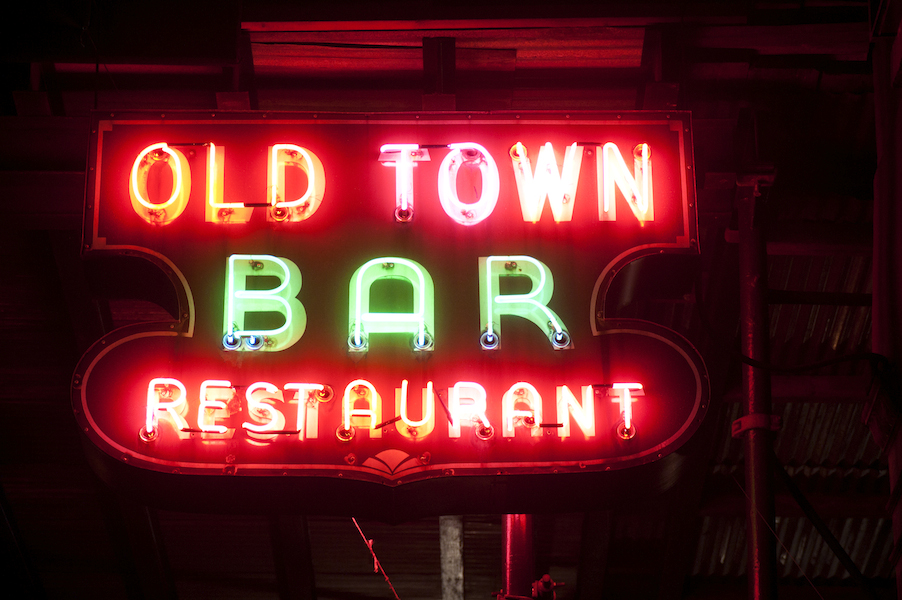The Old Town Bar has the right name. It’s an old bar in an old bar town. But it didn’t have that name to start. One hundred and twenty one years ago, it sold its first beer as Viemeister’s—a very German name, and for good reason. Union Square was a Teutonic stronghold back then. Luchow’s was nearby. So were Steinway Hall and the original FAO Schwartz.
Those landmarks are long gone, but Old Town remains.
None of this Bavarian history is discernible today at Old Town, which earned its current and lasting name when another German family, the Lohdens, bought it after Prohibition. In fact, you wouldn’t be blamed for thinking it was, and always had been, an Irish bar. Signed book jackets by Pete Hamill, Jim Dwyer and Frank McCourt, as well as a tribute by Liam Neeson, adorn the walls. That probably has something to do with the saloon’s current owners, brothers Gerard and Matthew Meagher. Their father Larry, a former copy boy at the New York Sun, bought the bar in the 1970s, when the area was down on its luck.
But Old Town Bar isn’t about German drinking traditions or Irish pride or anything so narrow as that. This is every New Yorker’s bar, a piece of ur-Gotham. The cozy, high-backed, dark-wood booths fill up early. (In 20 years of patronage, I’ve managed to snag a booth only once.) Large parties flow into the boxy back room. And by 7 p.m., the long bar is two deep with people ordering Guinness, Anchor Steam, Bud and, if they’re fancy, Martinis and Manhattans.
Though it has a small television, Old Town doesn’t need to switch on the day’s game to bring in trade. It has no jukebox or video games. It does not sell lottery tickets. Neither does it live and die by craft beer, barrel-aged cocktails and housemade bitters that have made the names of many of its ritzier nouveau neighbors.
The bar runs on tradition, companionship and conversation. Even on slow nights—and there aren’t many of those—the joint buzzes with chatter. Talk floats up to the 17-foot-high, brown-stained tin ceilings, the way smoke used to when you could light up in New York bars. The Meaghers encourage the flow of gab by banning cell phones, and by occasionally posting pithy, handwritten editorials in the window—an appealingly loopy practice begun by their father. (A recent one called the NFL a “criminal enterprise built on the twin pillars of gambling and violence.” Discuss.)
The convivial patronage keeps Old Town from getting old. This is very much a working tavern, not a museum. But in those brief moments of repose just after a draught from your pint, if you cast your eyes up and around, you can see how it could be a museum if the Meaghers wanted that. That is a working dumbwaiter at the end of the bar, bringing burgers and chili from the kitchen upstairs. The tulip-shape stained-glass lights crowning the towering beveled back-bar mirrors were originally gas fixtures. Waiters were once called with a press of the buttons near the booths and tables. And the glass cabinets near the front contain decades-old bottles of Four Roses and Calvert whiskey.
The Meaghers value history. This is a place that in 2010 celebrated the centennial of its majestic Hinsdale urinals. Mayor Bloomberg sent a congratulatory letter.
At the time, one of the Meaghers said something about how the urinals make a man feel more important than he really is. Too true. But the entirety of Old Town functions in that way. Those high ceilings make a person feel expansive. The collective warmth of the place imbues one with goodwill. And the layers of history surrounding you lend encouragement to take the long view, whatever your company or the topic at hand may be.
I’m sure Old Town has endured a fight or drunken display in its time, but I’ve never seen one. It’s not a bar for drunks. It’s a bar for meeting over a drink. It’s lubricated democracy at work.
Other ancient Manhattan saloons have as much charm, but not the same cross-section of society. McSorley’s Ale House gets overrun by college students on weekends. P. J. Clarke’s packs in the thousand-dollar suits. But all sorts file into Old Town after quitting time.
Makes sense when you think about it. Those bars are named after people. Old Town is named for the city itself.
Photo credit: Rebecca McAlpin



